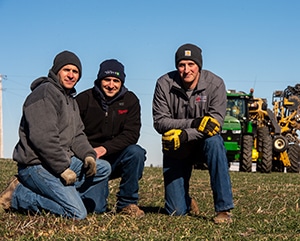Brandon and Austin Kliethermes received job offers of a lifetime in 2008 while attending the University of Missouri – to return home after college and be part of the family business, CADA Farms. The brothers haven’t looked back since. Today, the business includes CADA Turkey Farms, CADA Row Crop Farms, Inc. and CADA Feed Mill near Bunceton, Missouri.
In addition to producing 3 million pounds of turkey meat yearly, the farm includes 1,000 acres, plus 200 custom-farmed acres, evenly split with corn and soybeans. Austin manages the feed mill, micro ingredients and early turkey production, as well as spraying and some strip-tilling. Parents Helen and Carl manage turkey finishing, marketing and help with row-crop logistics. Brandon spearheads strip-till, nutrient applications, planting and leads the hedging and buying for the feed mill, farm inputs and grain sales.
After years of applying turkey manure on the farm, phosphorous buildup was a concern. So, the Kliethermeses started selling excess manure and transitioned to certain commercial fertilizers. Using a holistic approach to correctly manage the soil, they began the move to vertical tillage. After a short trial with a SoilWarrior® ETS, strip-till was a welcomed practice with a bonus of helping control erosion.
“We always liked the idea of cover crops and had started using them with help from local NRCS programs. Initially, we had planted some cover crops on cornstalks going to no-till soybeans. On soybean stubble going to corn we would vertical till,” Brandon says. “Even with this system of working the dirt and soybean stubble, we had a level of erosion I wasn’t happy with. Since we integrated the SoilWarrior, we’ve seen our water infiltration rates increase because we’re only working that 8- to 10-inch strip. When we get heavy rain events, there’s less soil moving out of the fields.”
Brandon works with John Reigelsberger, field sales and service/precision agronomy tech with AgriVision Solutions. They jointly plan soil sampling and testing, tissue sampling and nutrient and micronutrient selections.
“Getting the SoilWarrior is a big help with fertilizer placement,” Reigelsberger says. “We have tested and continue to test application rates with strip trials to analyze the data.” This, along with tissue sampling helped determine that we could back off earlier recommended application rates.”
“We also discuss what sources of P, K and boron to use,” he adds. “You need the right dry source of boron to put into a SoilWarrior and get it blended right. As far as placement goes, the SoilWarrior works well, plus Brandon is applying some nutrients in-furrow, as well.”
The 4R practices are proving worthy. Strip-till has allowed the CADA Farms team to use micronutrients at economical rates, even below spread recommendations for their yield goals. They’re also maintaining better tissue sampling results by implementing fertigation with the strip till fields. In addition, they’ve improved nutrient management and have cut P and K rates by 24 percent, while observing improved results from tissue samples.
Best Practice Management
- Cover crops
- Grid and zone soil sampling
- Variable-rate nutrient application
- Account for nutrient credits from previous year’s yield data to determine rate
- Account for nutrient credits from cover crops to determine rate
- Use end-of-season stalk test to evaluate crop uptake of nitrogen
